CaixaForum Madrid displays hundreds of valuable originals about the history of comics and its most iconic characters and creators
Every character from Western comics, of whatever type, ideology or technology, can be seen in the exhibition ‘Comic. Dreams and History’ hosted by CaixaForum Madrid. It is a great conclave of the ninth art. From Yellow Kid to Mafalda, it revisits and celebrates a century of history of a means of expression that has its roots in antiquity, in cave paintings or Egyptian hieroglyphics, and which blossomed in the second half of the 20th century. Today, its presence in museums and auctions continues to grow, as its popularity grows and opens new expressive avenues as a mirror of social changes and models of imagination.
On display until August 28, it contains 355 pieces, many from the collection of Bernard Mahé, one of the world’s greatest collectors, who owns more than a thousand masterpieces of the genre, 250 of which have been donated. van Tintin’s ‘Landing on the Moon’, drawn by Hergé (George Rémi) in 1954 for the first edition of album number 17 of the reporter’s series with the toupee and the bloomers, which could fetch three million euros at auction. Not surprisingly, Hergé’s original for the cover of ‘The Blue Lotus’ was auctioned in Paris last year for 3.1 million euros, making the Belgian cartoonist page the most expensive cartoon in history.
Mahé is the curator of the exhibition with 300 originals. “I wanted to tell the unpublished and complete history of Western comics with the best pieces,” says this French scholar, who does not clarify whether he is more ‘asterixophile’ than ‘tintinophil’, or vice versa, or whether he is willing to sell his Tintin -treasure. “I can’t choose between my children. I love them all equally. I have been collecting comics for 50 years and I love all the characters,” he justifies himself.
Mahé wants to value a now universal genre “undervalued because it is popular, ephemeral and of little importance”. “But comics today have a communicative scope that can hardly be achieved with any other means of expression,” he notes. He laments that for decades “the cultural and artistic value of comics has not been recognized”, although he celebrates that “it is gradually being consolidated as a form of expression that, related to literature, painting or film, has affected millions of people around the world.” has been conquered and has entered exhibition halls, museums and academia.”
The valuable page of Tintin, in black and white, is one of the many gems of the more than entertaining exhibition, which includes all those who are. It begins with an 1896 page of the famous Yellow Kid’s series, by Richard Felton Outcault, considered the first modern comic in the United States and which also gave its name to the “yellow press.” It continues to this day, with the online comic ‘Joselito’, by Marta Alperi, playing with the possibilities offered by the digital world, such as the concept of infinite ‘scrolling’, a functionality that automatically loads content when the user scrolls down on a screen.
The exhibition, which will travel through the centers of CaixaForum until 2026, will bring together “the best cartoons in the Western world”, according to the organizers, which “underscore the dual state of comics as a tool for reflection on the present and the future, and as a powerful means to create parallel realities, imaginary universes, utopias and dystopias.» This rich overview of comics is limited to the western world and does not deal with manga and other Asian genres.
There are rooms dedicated to giants such as Tintin or Asterix. Others to the great American and European heroes and also to the Spanish masters, with Francisco Ibáñez at the helm and a gigantic reproduction of his outrageous ’13 Rue del Percebe’. There are also classics that paved the way, from Captain Thunder to Carpanta or Zipi and Zape and a very long etcetera, along with the publications they appeared in, from ‘TBO’ to ‘Pulgarcito’ through ‘Flechas y Pelayos’ or ‘El víbora’, to name two in the temporal and conceptual antipodes.
Popeye, Mickey Mouse, Felix the Cat, Flash Gordon, Tarzan, Thor, Dick Tracy, Mortadelo and Filemón, Carlitos, Snoopy, Spirou, Corto Maltese, Makoki, Mafalda… the list of characters is as exhaustive as that of their creators : Winsor McCay, Claire Bretécher, Will Eisner, Frank Miller, John Romita, Jack Kirby, Moebius, Hugo Pratt, Quino, Francisco Ibáñez, Vázquez, Escobar, Paco Roca, Purita Campos, Garlos Giménez, Alberto Breccia, Enki Bilal or Robert Crumb .
Source: La Verdad
I’m Wayne Wickman, a professional journalist and author for Today Times Live. My specialty is covering global news and current events, offering readers a unique perspective on the world’s most pressing issues. I’m passionate about storytelling and helping people stay informed on the goings-on of our planet.



